Susan Price's Blog: Susan Price's Nennius Blog, page 12
December 20, 2013
It's Christmas! -
It's Not 'The Holidays!'
It's unreasonable of me, I suppose, but I'm annoyed by the increasing habit of referring to Christmas by using the American expression of 'the holidays.' - 'The Holidays are coming!' - 'Happy Holidays!'
As I understand it, the Christmas holiday is the only public, paid holiday in America. (Apologies to any American readers if I'm mistaken.) So it's understandable that they refer to the Christmas period as 'the holidays.'
But we're British, and it isn't so for us. We have many other public holidays - New Year, Easter, Whitsun, Bank Holidays - so why use the expression? It makes no sense in Britain.
In Britain, it's Advent. It's Christ's Mass and the Feast of St Stephen - or Boxing Day. It's New Year or Hogmanay. And then Epiphany and Candle Mass. These names have beauty and resonance.
The whole Christmas season is a Mid-Winter Feast, celebrating the solstice, that goes back century upon century. It's not merely, 'The holidays.'
I'm also coming to detest this character -

Not the actual man in the WikiCommons photo, of course. I've nothing against him. And it's not because Santa Claus or Kris Kringle in the red and white suit was invented by Coco-Cola. That's not actually true - though I'm sure Coke rejoiced when they saw how they could exploit it. Much older portrayals show the Christmas saint wearing red and white. After all, red and white are associated with Christmas for many reasons - snow, holly, purity, firelight...
But still, the old white-haired buffer in red and white has become increasingly associated with Coca-Cola, cosiness, Disney and sticky cuteness.
I much prefer this fella -
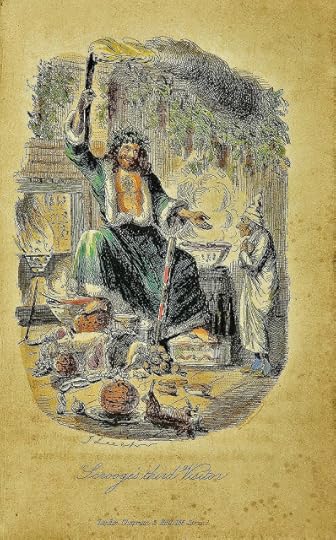
Everyone will know that this is the Cruikshank illustration of 'Scrooge's Third Visitor' - or The Ghost of Christmas Present - from Dickens' Christmas Carol. But neither Dickens nor Cruikshank invented this figure - indeed, Dickens' description, I think, shows that he is playfully describing for his readers a figure he knows they will recognise.
Scrooge opens the door of the room adjoining his bedroom to find it changed.
I much prefer this representation, because it harks back to still older beliefs - to the medieval Lord of Misrule, to the Roman Saturnalia, and to northern paganism, to Wodan and Frey.
Dickens' Ghost wears an empty scabbard 'eaten up with rust,' signifying 'the peace and goodwill on earth to all men' that is supposed to hold sway over Christmas. This didn't begin with Christianity. During the pagan celebration of Yule, peace was the rule - the Frey-frith, or Lord's Peace. ('Frey' is a title, not a name: it means 'Lord'. Something which made exchanging Frey for Christ the Lord easier.)
The ancient celebration of the Mid-Winter Solstice is about delighting in the survival of life through the months of cold and darkness - Oh, the holly and the ivy! It's about life having such strength and power that not even the coldest winter can suppress it - and the holly bears the crown. That's why Father Christmas is a strong, vigorous man with dark hair, dressed in green, crowned with a red-berried holly wreath.
For all his geniality, there's a slight chill of danger about Father Christmas - he may be seated beside a roaring fire, and presiding over a great feast, but it's icy, barren and dark outside. He may be young, but there's a sense of immense age about him. I much, much prefer him to Santa Claus.

Have a happy time on the Feast of the Returning Dead, as you set out food for your ancestors.(Christmas Eve, and the setting out of mince-pies and wine.)
Good Yule!
And Blot makes a return!
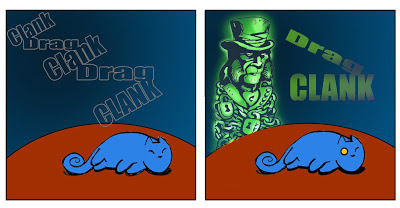
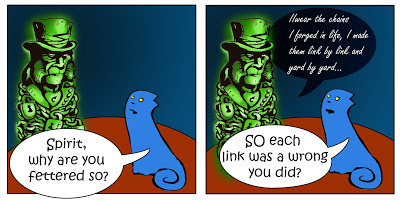 Spirit: These are the chains I forged in life. I made them link by lik and yard by yard....
Spirit: These are the chains I forged in life. I made them link by lik and yard by yard....
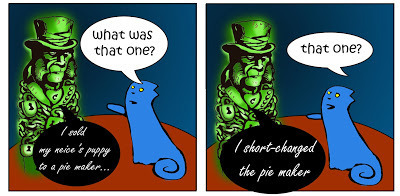 Spirit: I sold my neice's puppy to a pie-maker // I short-changed the pie-maker
Spirit: I sold my neice's puppy to a pie-maker // I short-changed the pie-maker
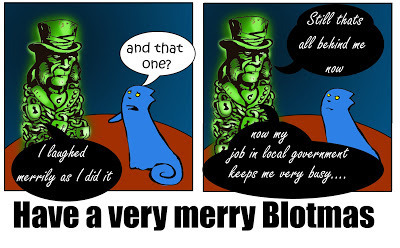 Spirit: I laughed merrily as I did it... Still, that's all behind me now. My job in local goverment keeps me very busy...
Spirit: I laughed merrily as I did it... Still, that's all behind me now. My job in local goverment keeps me very busy...
One reason for Blott's absence is that he badly cut his paw on a very sharp chisel while doing a bit of wood-carving. But he's handling the pen again now.
It's unreasonable of me, I suppose, but I'm annoyed by the increasing habit of referring to Christmas by using the American expression of 'the holidays.' - 'The Holidays are coming!' - 'Happy Holidays!'
As I understand it, the Christmas holiday is the only public, paid holiday in America. (Apologies to any American readers if I'm mistaken.) So it's understandable that they refer to the Christmas period as 'the holidays.'
But we're British, and it isn't so for us. We have many other public holidays - New Year, Easter, Whitsun, Bank Holidays - so why use the expression? It makes no sense in Britain.
In Britain, it's Advent. It's Christ's Mass and the Feast of St Stephen - or Boxing Day. It's New Year or Hogmanay. And then Epiphany and Candle Mass. These names have beauty and resonance.
The whole Christmas season is a Mid-Winter Feast, celebrating the solstice, that goes back century upon century. It's not merely, 'The holidays.'
I'm also coming to detest this character -

Not the actual man in the WikiCommons photo, of course. I've nothing against him. And it's not because Santa Claus or Kris Kringle in the red and white suit was invented by Coco-Cola. That's not actually true - though I'm sure Coke rejoiced when they saw how they could exploit it. Much older portrayals show the Christmas saint wearing red and white. After all, red and white are associated with Christmas for many reasons - snow, holly, purity, firelight...
But still, the old white-haired buffer in red and white has become increasingly associated with Coca-Cola, cosiness, Disney and sticky cuteness.
I much prefer this fella -

Everyone will know that this is the Cruikshank illustration of 'Scrooge's Third Visitor' - or The Ghost of Christmas Present - from Dickens' Christmas Carol. But neither Dickens nor Cruikshank invented this figure - indeed, Dickens' description, I think, shows that he is playfully describing for his readers a figure he knows they will recognise.
Scrooge opens the door of the room adjoining his bedroom to find it changed.
The walls and ceiling were so hung with living green, that it looked a perfect grove; from every part of which, bright gleaming berries glistened. The crisp leaves of holly, mistletoe, and ivy reflected back the light, as if so many little mirrors had been scattered there; and such a mighty blaze went roaring up the chimney, as that dull petrifaction of a hearth had never known in Scrooge's time... Heaped up on the floor, to form a kind of throne, were turkeys, geese, game, poultry, brawn, great joints of meat, sucking-pigs, long wreaths of sausages, mince-pies, plum-puddings, barrels of oysters, red-hot chestnuts, cherry-cheeked apples, juicy oranges, luscious pears, immense twelfth-cakes, and seething bowls of punch, that made the chamber dim with their delicious steam. In easy state upon this couch, there sat a jolly Giant, glorious to see:, who bore a glowing torch, in shape not unlike Plenty's horn, and held it up, high up, to shed its light on Scrooge, as he came peeping round the door.
"I am the Ghost of Christmas Present," said the Spirit. "Look upon me."
Perhaps Scrooge, in his meanness, had never seen the like of this visitor before - but Dickens' readers knew that the ghost was Father Christmas. The popular personification of Christmas in Dickens' time - and before - was a vigorous, dark-haired man in the prime of life, dressed in green and crowned with holly.Scrooge reverently did so. It was clothed in one simple green robe, or mantle, bordered with white fur. This garment hung so loosely on the figure, that its capacious breast was bare, as if disdaining to be warded or concealed by any artifice. Its feet, observable beneath the ample folds of the garment, were also bare; and on its head it wore no other covering than a holly wreath, set here and there with shining icicles. Its dark brown curls were long and free; free as its genial face, its sparkling eye, its open hand, its cheery voice, its unconstrained demeanour, and its joyful air. Girded round its middle was an antique scabbard; but no sword was in it, and the ancient sheath was eaten up with rust.
"You have never seen the like of me before!" exclaimed the Spirit.
"Never," Scrooge made answer to it.
I much prefer this representation, because it harks back to still older beliefs - to the medieval Lord of Misrule, to the Roman Saturnalia, and to northern paganism, to Wodan and Frey.
Dickens' Ghost wears an empty scabbard 'eaten up with rust,' signifying 'the peace and goodwill on earth to all men' that is supposed to hold sway over Christmas. This didn't begin with Christianity. During the pagan celebration of Yule, peace was the rule - the Frey-frith, or Lord's Peace. ('Frey' is a title, not a name: it means 'Lord'. Something which made exchanging Frey for Christ the Lord easier.)
The ancient celebration of the Mid-Winter Solstice is about delighting in the survival of life through the months of cold and darkness - Oh, the holly and the ivy! It's about life having such strength and power that not even the coldest winter can suppress it - and the holly bears the crown. That's why Father Christmas is a strong, vigorous man with dark hair, dressed in green, crowned with a red-berried holly wreath.
For all his geniality, there's a slight chill of danger about Father Christmas - he may be seated beside a roaring fire, and presiding over a great feast, but it's icy, barren and dark outside. He may be young, but there's a sense of immense age about him. I much, much prefer him to Santa Claus.

Have a happy time on the Feast of the Returning Dead, as you set out food for your ancestors.(Christmas Eve, and the setting out of mince-pies and wine.)
Good Yule!
And Blot makes a return!

 Spirit: These are the chains I forged in life. I made them link by lik and yard by yard....
Spirit: These are the chains I forged in life. I made them link by lik and yard by yard....
 Spirit: I sold my neice's puppy to a pie-maker // I short-changed the pie-maker
Spirit: I sold my neice's puppy to a pie-maker // I short-changed the pie-maker  Spirit: I laughed merrily as I did it... Still, that's all behind me now. My job in local goverment keeps me very busy...
Spirit: I laughed merrily as I did it... Still, that's all behind me now. My job in local goverment keeps me very busy...One reason for Blott's absence is that he badly cut his paw on a very sharp chisel while doing a bit of wood-carving. But he's handling the pen again now.
Published on December 20, 2013 16:05
December 13, 2013
Stop! Stop! - For God's Sake, Stop!
Or: Another Ninja Driving Update

On the 1st December I underwent a 'pre-test trial run' for the Advanced Driving Test. The last time I did this - several months ago - I was dreadful. I think it fair to say that I drove worse during that hour than before I started the IAM course. This was partly due to the brain-crash of trying to change old, ingrained habits and partly to sheer nervousness.
So I wasn't looking forward to this second go, despite knowing that I had improved considerably. And within the first ten minutes I was told, "If this was a real test, you would just have failed." That was because, at a road-junction I 'totally paused' (as the girl says in 'Clueless',) checked that the way was clear and sailed on in fine style. Which is what you're supposed to do at a Give Way.

Only it wasn't a Give Way - it was a mandatory 'Stop.' You are legally required to stop at one of them, and the IAM test requires that you put on the handbrake - just to prove to the examiner that you know you have to stop and you have stopped.
I didn't. And a bit later, I did it again. (The examiner having cunning guided me round to another Stop sign, just to see what I would do.)
Further on, I overtook a slow moving VW on a dual-carriageway - with mirror-checks, over the shoulder checks, signals and all - and then found myself holding up a big 4x4 that was close behind me (trying to climb into my boot.) So I checked mirrors, signalled, made sure that I could see the whole of the VW's front in my off-side mirror, and moved over to the left. Seconds later, the VW I'd overtaken a minute earlier overtook me.
"Why do you think the VW overtook you?" the examiner asked, in that calm, expressionless way they ask pointed questions.
"Because I was too close to it when I pulled over?"
"Because you pulled over and then slowed down," the examiner said. "So you left him nowhere to go and he had to overtake you."
Shortly after, he said, "You used a variety of lanes on that roundabout."
"I know," I said. "I've been mentally kicking myself ever since."
 He burst out laughing. "First time I've heard that - mentally kicking yourself! I didn't think you'd noticed."
He burst out laughing. "First time I've heard that - mentally kicking yourself! I didn't think you'd noticed."
"Oh, I did. Believe me, I did."
I was keeping up the required commentary. "Brake lights coming on in the distance - slowing down... Roundabout, preparing to stop, looking to go - Traffic lights, check mirrors, clear behind... lights changed, but I'm too close to stop...Pedestrians, with dog - cyclists - car turning round in that side junction...Garage forecourt, may be vehicles pulling out... Slowing because coming into residential area, lots of parked cars..." And so on.
I reversed around a left-hand bend - first remembering to look into the road I was going to reverse in, and to observe other traffic around me. (I waited for one car to get well clear.) The reverse itself was pretty good, as even the examiner admitted. I've done better when alone - closer to the kerb throughout, more controlled - but still, it wasn't bad. (Thank the Gods he didn't ask me to parallel park! I've watched videos on this, and practiced whenever I can find other cars suitably parked. I can do one perfectly and then, two minutes later, make a complete pig's breakfast of another. The secret, I think, is in firmly applying the 'one full lock' - no more and no less.)
At one point the examiner announced that he was 'presently' going to ask me to name the last three road signs we'd passed. I inwardly groaned... But he never did. Whether this was because I sang out the road-signs as part of my commentary, or whether he simply forgot (which seems unlikely), I don't know.
We drove on a variety of roads - though not motorway. We turned onto country lanes with tempting 'National Speed Limit Applies' signs. Commentating, I said, "National Speed Limit, but I don't know this road, it's wet and covered with wet leaves, there are lots of bends and high hedges limiting my view, and there's no way I'm doing anything like 60 here." I heard a grunt of approval from my left.
On some dual carriageways, though, with little traffic and a long, clear straight road ahead, I block-changed into fifth and went for it. ('Block-changing' means going from second directly into fourth, or from third into fifth - and changing down in the same way - when speed and conditions allow. And NSL on a dual carriageway with barriers down the centre is 70, unless otherwise signed. On other roads, 60.)
We arrived back at the examiner's house much sooner than I'd expected. As seems to be the custom, he asked me, "How do you think that went?"

I said, "A hell of a lot better than the last time we did this, but I still failed on observation and exceeding the speed limit."
He took me through all my failings again. "You failed to stop at two 'Stop' signs. With speed, you were on the button at forty and over, but where the limit was thirty you were usually doing somewhere nearer 38. Now you might get away with that once on a test, but more often than that and you'll fail. Don't choose a gear unless you intend to use it. Stick to your lane. There was that roundabout where you wandered about - and in another place, I asked you to turn right and instead of turning sharply inside the lane markings, you went too far forward to make the turn and then had to loop back."
At this point, I was gripping the wheel, inwardly seething and mentally kicking him. I don't take criticism well - I only pretend to.
Then he said, "There were good points. We covered a great deal of ground in a very short time!"
"Thanks," I said, though gritted teeth. "A back-handed compliment."
"Well, put it another way," he said. "You certainly weren't hesitant. You certainly 'maintained progress' - and within bounds, that's good. I've driven with people who come up to an empty roundabout with no one in sight, and they stop dead at the give-way line and look all round before creeping over. And I've driven with others who find it hard to force themselves to drive over thirty miles an hour - which doesn't seem to be a problem for you. Forcing yourself to drive at thirty occasionally would be nice. - I quite liked your commentary. - Most of the time you had a lovely flow at roundabouts. - I have to agree, a great improvement, and I think there is a severe likelihood that you may pass this test. With a little more sharpening up."
My usual mentor, Brian, had been quiet as a mouse in the back all this time. (And in justice, it should be said, that Brian has been patiently telling me for weeks that I have to stop at 'Stop' signs and put on the hand-brake, even if only for a second 'just to show that you've stopped.' But it hasn't penetrated my skull.) Now Brian piped up and said, "Another couple of weeks, then, Sue, and we'll book another drive with Jeff here."
"Another couple of weeks and then the test, I think," Jeff said.
So there you are. So close... If I can learn to recognise a Stop sign when I see one.
 Note to self: they look like this
Note to self: they look like this
At least all this driving has helped me solved the problem of what to buy Davy - the Scot who always wants a Christmas present, 'because it's good to have a wee something to open on the day,' but doesn't actually want anything. And doesn't drink, or smoke, or eat sugar, and is more fussy about clothing than anybody I've ever known. And dismisses almost anything else as 'daft.'
I reported on my driving progress and he was chuffed, because he bought me the IAM course as a Christmas present last year. I said, "How would you like a skid-pan session?"
"Ooh, Susie, that would be expensive."
"I know it would be expensive, Davy. Somebody has to get the economy moving. Would you like it?"
"It certainly sounds adventurous."
Which is as near to his saying he'd like it as I'm ever likely to get. So I've gone ahead and booked a skid-pan session for two at a knock-down price. A His-and-Her day out, driving a car and skidding it. (There's no fear that this blog will spoil the surprise. He'll have forgotten by Christmas Day, and he never reads what I write here.)
I need the skid-pan practice too - it was skidding on the M6 and writing off a car that led to me taking an Advanced Driving Course in the first place. Which I might pass if I can just remember these,



On the 1st December I underwent a 'pre-test trial run' for the Advanced Driving Test. The last time I did this - several months ago - I was dreadful. I think it fair to say that I drove worse during that hour than before I started the IAM course. This was partly due to the brain-crash of trying to change old, ingrained habits and partly to sheer nervousness.
So I wasn't looking forward to this second go, despite knowing that I had improved considerably. And within the first ten minutes I was told, "If this was a real test, you would just have failed." That was because, at a road-junction I 'totally paused' (as the girl says in 'Clueless',) checked that the way was clear and sailed on in fine style. Which is what you're supposed to do at a Give Way.

Only it wasn't a Give Way - it was a mandatory 'Stop.' You are legally required to stop at one of them, and the IAM test requires that you put on the handbrake - just to prove to the examiner that you know you have to stop and you have stopped.
I didn't. And a bit later, I did it again. (The examiner having cunning guided me round to another Stop sign, just to see what I would do.)
Further on, I overtook a slow moving VW on a dual-carriageway - with mirror-checks, over the shoulder checks, signals and all - and then found myself holding up a big 4x4 that was close behind me (trying to climb into my boot.) So I checked mirrors, signalled, made sure that I could see the whole of the VW's front in my off-side mirror, and moved over to the left. Seconds later, the VW I'd overtaken a minute earlier overtook me.
"Why do you think the VW overtook you?" the examiner asked, in that calm, expressionless way they ask pointed questions.
"Because I was too close to it when I pulled over?"
"Because you pulled over and then slowed down," the examiner said. "So you left him nowhere to go and he had to overtake you."
Shortly after, he said, "You used a variety of lanes on that roundabout."
"I know," I said. "I've been mentally kicking myself ever since."
 He burst out laughing. "First time I've heard that - mentally kicking yourself! I didn't think you'd noticed."
He burst out laughing. "First time I've heard that - mentally kicking yourself! I didn't think you'd noticed.""Oh, I did. Believe me, I did."
I was keeping up the required commentary. "Brake lights coming on in the distance - slowing down... Roundabout, preparing to stop, looking to go - Traffic lights, check mirrors, clear behind... lights changed, but I'm too close to stop...Pedestrians, with dog - cyclists - car turning round in that side junction...Garage forecourt, may be vehicles pulling out... Slowing because coming into residential area, lots of parked cars..." And so on.
I reversed around a left-hand bend - first remembering to look into the road I was going to reverse in, and to observe other traffic around me. (I waited for one car to get well clear.) The reverse itself was pretty good, as even the examiner admitted. I've done better when alone - closer to the kerb throughout, more controlled - but still, it wasn't bad. (Thank the Gods he didn't ask me to parallel park! I've watched videos on this, and practiced whenever I can find other cars suitably parked. I can do one perfectly and then, two minutes later, make a complete pig's breakfast of another. The secret, I think, is in firmly applying the 'one full lock' - no more and no less.)
At one point the examiner announced that he was 'presently' going to ask me to name the last three road signs we'd passed. I inwardly groaned... But he never did. Whether this was because I sang out the road-signs as part of my commentary, or whether he simply forgot (which seems unlikely), I don't know.
We drove on a variety of roads - though not motorway. We turned onto country lanes with tempting 'National Speed Limit Applies' signs. Commentating, I said, "National Speed Limit, but I don't know this road, it's wet and covered with wet leaves, there are lots of bends and high hedges limiting my view, and there's no way I'm doing anything like 60 here." I heard a grunt of approval from my left.
On some dual carriageways, though, with little traffic and a long, clear straight road ahead, I block-changed into fifth and went for it. ('Block-changing' means going from second directly into fourth, or from third into fifth - and changing down in the same way - when speed and conditions allow. And NSL on a dual carriageway with barriers down the centre is 70, unless otherwise signed. On other roads, 60.)
We arrived back at the examiner's house much sooner than I'd expected. As seems to be the custom, he asked me, "How do you think that went?"

I said, "A hell of a lot better than the last time we did this, but I still failed on observation and exceeding the speed limit."
He took me through all my failings again. "You failed to stop at two 'Stop' signs. With speed, you were on the button at forty and over, but where the limit was thirty you were usually doing somewhere nearer 38. Now you might get away with that once on a test, but more often than that and you'll fail. Don't choose a gear unless you intend to use it. Stick to your lane. There was that roundabout where you wandered about - and in another place, I asked you to turn right and instead of turning sharply inside the lane markings, you went too far forward to make the turn and then had to loop back."
At this point, I was gripping the wheel, inwardly seething and mentally kicking him. I don't take criticism well - I only pretend to.
Then he said, "There were good points. We covered a great deal of ground in a very short time!"
"Thanks," I said, though gritted teeth. "A back-handed compliment."
"Well, put it another way," he said. "You certainly weren't hesitant. You certainly 'maintained progress' - and within bounds, that's good. I've driven with people who come up to an empty roundabout with no one in sight, and they stop dead at the give-way line and look all round before creeping over. And I've driven with others who find it hard to force themselves to drive over thirty miles an hour - which doesn't seem to be a problem for you. Forcing yourself to drive at thirty occasionally would be nice. - I quite liked your commentary. - Most of the time you had a lovely flow at roundabouts. - I have to agree, a great improvement, and I think there is a severe likelihood that you may pass this test. With a little more sharpening up."
My usual mentor, Brian, had been quiet as a mouse in the back all this time. (And in justice, it should be said, that Brian has been patiently telling me for weeks that I have to stop at 'Stop' signs and put on the hand-brake, even if only for a second 'just to show that you've stopped.' But it hasn't penetrated my skull.) Now Brian piped up and said, "Another couple of weeks, then, Sue, and we'll book another drive with Jeff here."
"Another couple of weeks and then the test, I think," Jeff said.
So there you are. So close... If I can learn to recognise a Stop sign when I see one.
 Note to self: they look like this
Note to self: they look like thisAt least all this driving has helped me solved the problem of what to buy Davy - the Scot who always wants a Christmas present, 'because it's good to have a wee something to open on the day,' but doesn't actually want anything. And doesn't drink, or smoke, or eat sugar, and is more fussy about clothing than anybody I've ever known. And dismisses almost anything else as 'daft.'
I reported on my driving progress and he was chuffed, because he bought me the IAM course as a Christmas present last year. I said, "How would you like a skid-pan session?"
"Ooh, Susie, that would be expensive."
"I know it would be expensive, Davy. Somebody has to get the economy moving. Would you like it?"
"It certainly sounds adventurous."
Which is as near to his saying he'd like it as I'm ever likely to get. So I've gone ahead and booked a skid-pan session for two at a knock-down price. A His-and-Her day out, driving a car and skidding it. (There's no fear that this blog will spoil the surprise. He'll have forgotten by Christmas Day, and he never reads what I write here.)
I need the skid-pan practice too - it was skidding on the M6 and writing off a car that led to me taking an Advanced Driving Course in the first place. Which I might pass if I can just remember these,


Published on December 13, 2013 16:05
December 6, 2013
An Old Friend

Let me introduce an old friend.
I've known him my entire life.
My mother - who housed him before me - called him, 'The Old Chinaman' - though, as a child, I never knew if she meant that he was Chinese or that he was made of china.
I don't know how my mother acquired him. She always referred to him as 'one of my Woolworth's specials', but I have a feeling that she took him over from my grandmother rather than buying him herself. Whichever, she was very fond of him.
He is a posy-bowl.

I was very pleased when - at about eight - I was considered responsible enough to provide the little flower-seller with stock. His large urn had to be filled with small-ish flowers: wild geraniums. daisies, bluebells, coltsfoots. In his hand he has a tiny pot which will hold one tiny flower - a single daisy, or violet, a single sprig of London's Pride. In the photo above, he has a small white geranium bud in his hand.
He is quite small: less than a hand-span high. About the height of a small mug.
I used to like imagining him standing in some crowded market-place or street, offering his flowers for sale.
As a big fan of Hans Christian Andersen (which I still am), I was firmly convinced that my mother's ornaments came to life at midnight. My parents said that they didn't, but I reasoned that Andersen was an adult too, like them, and he said that ornaments did have their own secret life. My parents, I thought, were telling porkies because they wanted me to stay in bed after I'd been sent there. (They were unreasonably insistent about this.)
I have a memory - which I'm not quite sure is real - of managing to stay awake until my parents came up to bed, and then sneaking downstairs, to see what the ornaments were up to. But they heard me coming, rushed back to their places and kept still and stum. I waited a while, to try and catch them out - I hid behind the door, pretending I'd gone away. But the ornaments were too cunning for me. I got cold, and went back to bed.
I was sure that, if my timing had been better, or I'd been quieter, I would have seen them climbing down from the mantelpiece, just as the china shepherd and shepherdess climb down in Andersen's story. (There's an old china Chinaman in that story too.)
I had quite a complicated relationship with my mother's ornaments. There was a large china mallard, an African fishing from a canoe, a couple involved in domestic violence... She would often let me play with them, to keep me quiet. She said that in the year I started school I was a pure hell-bat - because, she theorised, of the strain of behaving well all day for the teacher. Once at home again, I let rip with all that pent-up mischief. A little peace and quiet was worth risking a few broken trinkets - though I don't remember breaking any of them.

The old chinaman is in my house now, safe for another few years. I have a friend whose instant response to being shown something like this, is, 'It's not worth anything.' Well, I know it isn't! Not in money, anyway. I always knew it was nothing but 'a Woolworth's special' and have no illusions about it being some long lost, valuable antique. It's a cheap posy bowl which, even when new, was probably not worth more than the equivalent of a couple of pounds today. I love it. That's all.
Comments are always welcome, but I may not be able to respond this week, because I shall be away on an RLF Training Course.
Published on December 06, 2013 16:05
November 29, 2013
Poor Wolf
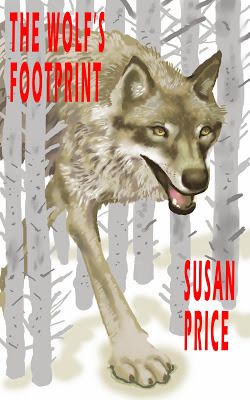 The-Wolfs-Footprint by Susan-Price
The-Wolfs-Footprint by Susan-PriceDid you see the recent news story about the wolves that
escaped from Colchester Zoo?
Five escaped. One turned round and went back to captivity immediately. One was darted and recaptured. Two were shot, and one, at time of writing, was still on the loose.
What a great shame. Those wolves should have just been left alone to get on with it. They are, after all, native to Britain. And they were here before us.
Osprey have been brought back, and Red Kites. Beavers have been re-introduced with great success. After all, if you want to preserve and maintain wet-land habitat, beavers are the lads to do it.
Wolves and Brown Bears should be next. Those five wolves had voted with their paws, and should have been allowed to vanish into the 'thick undergrowth' in which the last escapee is said to be hiding, and begin the long climb-back.
Who's with me on this? I know my partner isn't. This is one of the suggestions with which I annoy him on a regular basis. "That's just daft, Susie," he says. "You're just saying that to be contrary."
But why not? Despite living in the Black Country, open countryside is quite near, and there are 'beware of deer' signs on those country roads. People who live out there complain of the deer destroying their gardens. On the Clent Hills, newly planted trees have to be fitted with guards to prevent the deer from killing them. Farmers complain about them too. Beautiful though deer are, there are just too many of them.
On Cannock Chase, and no doubt many other places, sharp-shooters have to be employed to shoot deer, to keep their numbers down. Animal lovers often protest, but if some of the deer weren't shot, a great many more of them would starve, because there isn't enough countryside to support their numbers. Why? Because we've cut through the food-chain. We've removed the top predator, the wolf.
If there was a wolf-pack on Cannock Chase, the deer numbers would be kept in check by predation - but the wolf-pack would be kept in check by the number of deer. If deer numbers fall, so do the wolf-numbers. When deer numbers rise, so do the wolf-numbers. This is the way it was meant to be.
Just as reintroducing beavers has improved wet-land
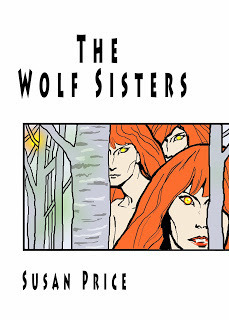 The-Wolf-Sisters by Susan-Price
The-Wolf-Sisters by Susan-Price environments, reintroducing wolves has similar benefits.
After wolves were reintroduced to Yellowstone National Park, Wyoming scientists discovered that aspen and cottonwood groves recovered - not because wolves were killing all the elk, but because the elk stopped standing around and grazing like domestic livestock...Aspens and cottonwood grow in fragile stream areas which are extremely sensitive to overgrazing...From this website.When the elk stopped destroying so many trees, beaver numbers grew, and beavers created more dams and wetland, which encouraged the growth of more wetland vegetation. This, in turn, provided habitat for more birds and insects. This is known as a 'trophic cascade' where one addition (or subtraction) to an environment produces many more changes.
Another change is that wolves kill steadily throughout the year, but don't eat all of their kill. What they leave provides food for many scavenging species, from small mammals to birds and insects, who would otherwise have problems surviving.
Reintroducing wolves in the UK would have a similar beneficial effect on our countryside. One inescapable fact is: they are meant to be here. Without them, our ecology is out of whack.
Of course, there would be protests. It happened in America, in Yellowstone and other areas where wolves have been 're-wilded.' Every cow or sheep killed by a wolf was greeted by major press coverage and screams of outrage. After all, in 2003, wolves killed 500 sheep in Montana.
500. That's a lot of sheep.
During the same year, coyotes - which had always been present and were accepted as part of the local wildlife - killed 11,800. There was no press coverage of those killings, but that twenty-three and a half times more sheep than were killed by wolves.
Overall documentation shows that weather and disease kill far more livestock than wolves. Killings by wolves amount to 1% of the total causes of livestock loss.
Put it another way - 99% of livestock loss is NOT caused by wolves.
But wolves are Big and Bad, aren't they?
Davy says, think of all the losses Scottish estates will make, if they can't charge (human) hunters thousands of pounds to shoot red deer.
Well, my heart bleeds. Apart from the fact that wolves (see above) don't kill all the deer, and there would still be some for people to shoot - think of the money the estate would make from expeditions to see the wolves.
How would you feel, Davy says, if you lived in the country and had to wait at a dark bus-stop when there were wolves about?
Well, I would be thrilled. It would add a whole new dimension to the tedious chore of catching a bus.
How do you think people with kiddies will feel, when they have to walk to school, with wolves?
Well, I would think when kiddies are walking to school, the wolves would be asleep. Also, it can't be said enough, that wolves are skittish, wary creatures, who don't like bright lights, loud noises or people. Fairly easy things to scare away. Take a torch with you and be prepared to shout, stamp and clap.
A friend met a ranger in Yellowstone Park who'd worked there for twenty years and had never seen a wolf - and he wanted to see them, he was on the watch for them. He'd heard them, had found remains of their kills and their tracks and droppings, so he knew they were about. But he had never seen one, although he saw bears and elk nearly every day.
Ah, but what about when wolves become urban, like foxes? What about when you've wolf-packs running through the streets, turning your dustbins over?
I can only say: Bring it on.
Over to you lot. What do you think. Don't spare mine, or the wolves' feelings. Have your say.
Art work above, copyright Andrew Price
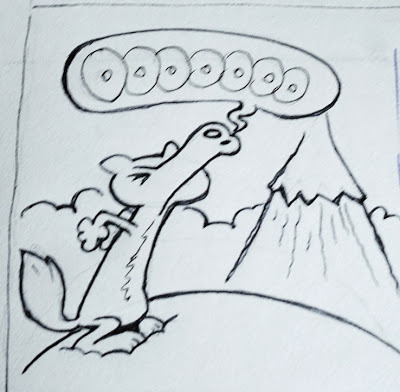
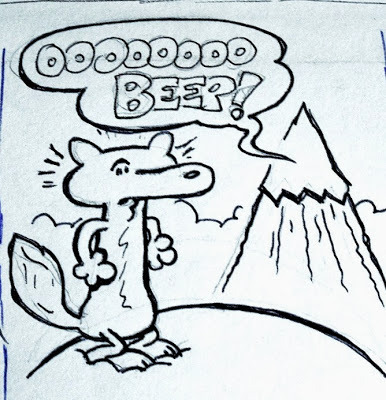
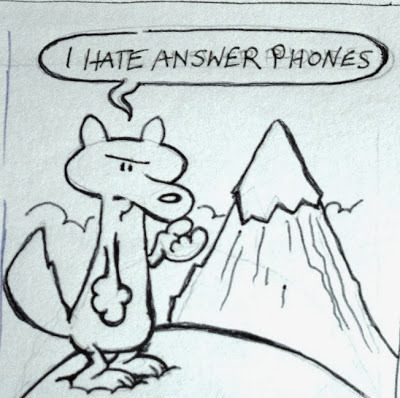
Wolf cartoon, copyright Adam Price
After wolves were reintroduced to Yellowstone National Park, Wyoming scientists found that aspen and cottonwood groves recovered � not because wolves were killing all the elk, but because elk stopped standing around grazing like domestic livestock.
Similarly, wolves, by preying on elk and moose populations, have helped willow and fir groves to recover in other parts of the US and Canada. Willows, aspens, and cottonwoods all grow in fragile stream areas, which are extremely sensitive to over-grazing.
- See more at: http://www.jyi.org/issue/restoration-... wolves were reintroduced to Yellowstone National Park, Wyoming scientists found that aspen and cottonwood groves recovered � not because wolves were killing all the elk, but because elk stopped standing around grazing like domestic livestock.
Similarly, wolves, by preying on elk and moose populations, have helped willow and fir groves to recover in other parts of the US and Canada. Willows, aspens, and cottonwoods all grow in fragile stream areas, which are extremely sensitive to over-grazing.
- See more at: http://www.jyi.org/issue/restoration-... wolves were reintroduced to Yellowstone National Park, Wyoming scientists found that aspen and cottonwood groves recovered � not because wolves were killing all the elk, but because elk stopped standing around grazing like domestic livestock.
Similarly, wolves, by preying on elk and moose populations, have helped willow and fir groves to recover in other parts of the US and Canada. Willows, aspens, and cottonwoods all grow in fragile stream areas, which are extremely sensitive to over-grazing.
- See more at: http://www.jyi.org/issue/restoration-...
Published on November 29, 2013 16:05
November 22, 2013
A Tudor Fence
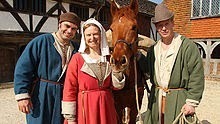 The Tudor Monastery Farm team: my heroine, a horse and them other two I was watching the new BBC programme, The Tudor Monastery Farm the other day.
The Tudor Monastery Farm team: my heroine, a horse and them other two I was watching the new BBC programme, The Tudor Monastery Farm the other day.I was late to it, as I record everything I want to see, and then watch the recording.
I keep strange hours. I'm likely to be watching telly at 8-30 in the morning, and working at 10-30 at night.
Anyway, there I was, watching the shennanigans on the Tudor Farm. (I love Ruth Goodman.) And they built a fence.
Hmm, I went.
Because I need to build a fence.
I might have mentioned before how my garden went feral. My garden isn't extensive - a little patch in front and a slightly larger (and steep) patch at the back. I moved into this house in 2002, and for the first few years, I kept the undergrowth in check - although the rhubarb was ferocious, and would produce enormous leaves that shadowed everything else.
But from 2007 through to 2009, my parents were ill, with first my mother dying, and then my father. So, for six years I've either not had the time or the heart to do much gardening.
Experiments have been done which involved fencing off a four-foot square patch of downland, and then observing it. The fencing keeps the sheep and deer out, and, in that little square, The Ancient British Wood returns with surprising speed - first the briars and bushes, and then the saplings of the larger woodland trees.
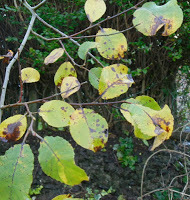 My beech That's been happening, while I was looking away, in my back yard. There always was a hawthorn hedge at the back, between my patch and the neighbour's garden that backs onto it. The hedge is reaching its branches far over into my space now - and I have a beech tree up there! It's already well over seven foot tall, with one branch reaching for the sky.
My beech That's been happening, while I was looking away, in my back yard. There always was a hawthorn hedge at the back, between my patch and the neighbour's garden that backs onto it. The hedge is reaching its branches far over into my space now - and I have a beech tree up there! It's already well over seven foot tall, with one branch reaching for the sky.
There's a fine crop of mushrooms up there too, growing on some rotten wood. I rather like the idea of having my own tiny wood at the top of the garden. Maybe fairies will move in.
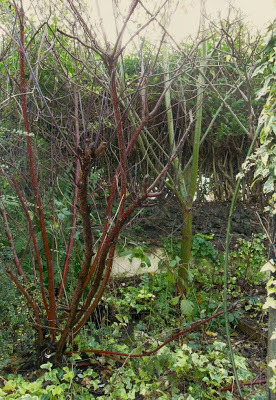 My wood But I was talking about the fence. - There was a fence between my next door neighbour's garden and mine. Close against it, on my neighbour's side, grew a rowan. On my side, I had planted a mile-a-minute Montana clematis. Every spring, it raced up into into rowan and hawthorns, and was beautiful.
My wood But I was talking about the fence. - There was a fence between my next door neighbour's garden and mine. Close against it, on my neighbour's side, grew a rowan. On my side, I had planted a mile-a-minute Montana clematis. Every spring, it raced up into into rowan and hawthorns, and was beautiful.It's this clematis and the rowan which worked together to pull down the fence. While I wasn't paying attention, the clematis wove and tied itself into a complicated net between all the trees, fence-posts and bushes nearby, and tugged and twisted the trees' branches down.
It was already dragging at the fence and leaning on it - and then came a couple of winter's of heavy snowfalls. The weight of all that snow in the net of creeper and branches finally did for the fence. It also did for a bit of fence between my garden and the one above mine.
So I needed to build a short stretch of fence - partly to keep out wandering dogs - and partly because the house above mine is empty at the moment, and I don't like there being a wide open passage through from the next street into my garden.
I was hindered by having no practical knowledge of how to build a fence, and lacking the spare cash to pay somebody to do it for me.
So I sat up and watched with keen interest when the Tudor Farm crew built their fences. They made two. One was a 'dead hedge' fence, or a 'laid hedge' which would be beyond me. I don't have the skill, or a hedge in the right place.
But the other fence was, basically, a rough interweaving of cut branches and scrub. It was bulky, and not pretty, but effective. Ruth gleefully threw herself on it, and bounced off, to demonstrate how impenetrable it was.
I've been - at last - tackling my overgrown garden. I have a lot more still to cut down - hawthorn and dogwood, and some branches from a climbing rose with particularly vicious thorns. There's huge amounts of old creeper, too. I wonder, I thought, if I can use all that to build a similar fence? (Thorns were highly recommended, as being especially discouraging.)
So, this morning, I was up the garden, wellie boots on, armed with gardening gloves, a pair of clippers and a saw. (I shall have to get me an axe.)
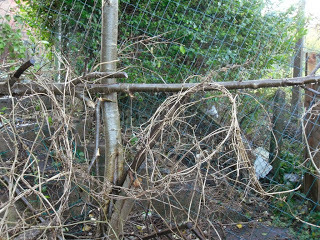
After a mere thirty minutes of work, I had the start of a pretty convincing fence. And a use for all those clippings I shall be creating over the next few weeks, as I chop down the dogwood and cut back the hawthorn.
I came bouncing back into the kitchen feeling very pleased with myself. And with fingers and toes fairly burning from the cold.
The BBC - entertaining and educating. Neighbour shall speak unto neighbour, over a brushwood fence.
Published on November 22, 2013 16:05
November 8, 2013
Strong Female Characters
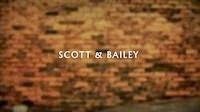
I've just been reading an article in The Guardian, on Joss
Whedon being commended for creating 'strong female characters' in his TV shows. The article points out that he was honoured for the same thing seven years ago, and that nothing, really, has changed. That he could have re-used his acceptance speech from the previous occasion, and no one would have known.
This made me sigh a bit. One of my favourite TV programmes is 'Scott and Bailey.' It's also a favourite with my (male) partner. Recently we've been watching the repeats, because it's often still the best thing on, even when we've seen it twice before. Excellent scripts, excellent acting.
But every time we watch it - every time - my partner says something like, 'It's good, but it's hard on men.'

Or, 'It's good, but it isn't fair to men at all.'
And, 'You can grind your teeth all you like, Susie, but it isn't fair to men, it really isn't. All the men in it are incompetent or stupid. It's really hard on the men just to make the women look good.'
Every time.
I'm getting tired of re-stating the argument that follows, so let's set my answer down here. Then, instead of repeating myself, I can email him a link. In fact, I can schedule the link to be sent to him after each episode.
Scott and Bailey - a series based around three women detectives in a Major Incident Team - is not, let me repeat that, NOT, unfair to men.
All it does - and this is important - is treat the women characters as central instead of peripheral.
In other words, it tells the story from the women's side, and sees the world through the women's eyes. That's all. But it seems that some men can't tolerate this. Despite the fact that women have had to put up with the world being shown through men's eyes, as a norm, for centuries.
It does not - NOT - portray all the male characters as 'stupid or incompetent.' It shows them as less than perfect - as human, in other words. But that's all.
And - let it be noted - the female characters aren't perfect, either.Few characters in fiction are, because perfection tends to be boring.
There are several male characters in the show who are sympathetic, intelligent, and good at their jobs. But they are not - and this makes all the difference - central to the stories. They are secondary characters. They sit in on interviews. They exchange a bit of banter with our heroines. But they don't carry the show.
Another show could be written around any one of them, but not Scott and Bailey.
One of the story-lines in the repeated series we've been watching concerns the marriage problems of DC Janet Scott, who has a fling with fellow DC, Andy. She soon regrets it, but Andy mistakes their affair for something much more serious. He is hurt and reacts badly, causing trouble for Janet both at work and home.
"See?" says my partner. "They're making out he's a shit. It's always written so the men look bad."
But imagine, for a moment, that the story was written from Andy's point of view. This intelligent, hard-working DC falls hard for an attractive female colleague. She leads him on and gives him the impression that she's going to leave her husband for him - but instead she dumps him and returns to her husband.
Andy, disappointed and dreadfully hurt, can't keep himself from lashing out - though he knows he shouldn't - and behaves in a less than professional manner despite being, at heart, a decent man and a good officer.
Sound familiar? How many angst-ridden, troubled male police officers - flawed, struggling to do the right thing, but still good men - have we seen on our screens?
Suppose my partner and I had been watching this programme - 'Andy'. Somehow, even when I'm trying, I can't imagine my partner saying, 'This programme is really unfair to women characters. This programme is written so that all the female characters are made to look incompetent, flighty and stupid. The way they have that female detective cheat on her husband makes out that all women are shits. It's really unfair.'
In fact, as we've watched programmes where women are characterised as nags, whores, air-heads, feckless child-abandoners, manipulaters, gossips, or simply pretty objects, I've never once heard him say, 'This is really unfair and makes women look bad/shallow/one-dimensional.'
When women are the secondary, shallow characters, with unexplored motivations - when it's women who are merely there as set-dressing, sitting in on interviews or listening to the hero's soul-searching, without creating the action - well, that's not worth comment, it seems. That's the norm.
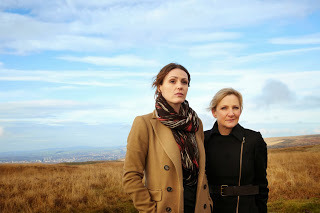 But if, in just one or two programmes, male characters are given the same treatment, that's uncomfortable viewing. Unnatural. Can't be allowed to pass. Ever.
But if, in just one or two programmes, male characters are given the same treatment, that's uncomfortable viewing. Unnatural. Can't be allowed to pass. Ever. From the very first episode we watched of Scott and Bailey to the most recent, my partner has complained that it is biased, that it makes men look bad, that it's written 'as if women can do no wrong.'
(For God's sake.)
In fact, Rachel Bailey drinks too much, sleeps around and has terrible taste in men. She sometimes fails to do her job properly because of her car-crash of a private life. Does that sound like 'making out that women can do no wrong?'
Janet Scott, although a good officer, is stuck in a dreary marriage, and admits that she and her husband have put up with this state of affairs for far to long 'for the sake of the kids.' It's this boredom and unhappiness which lead her into an affair - but she soon realises it was a big mistake. She ends the affair and tries to patch up her marriage. (It's not the originality of the story-line which makes me admire this series: it's the writing and acting.)
By beginning and ending this affair, she deeply hurts both her lover and her husband. At no point (in my opinion) are these men portrayed unfairly. The failure of the marriage is not blamed entirely on the husband, and he only gives up on it when he discovers that his wife was seeing her colleague before they separated. So, it seems to me, that the woman is shown behaving as badly, or even worse than, the men. But since the story is told from her point of view, we are given far more insight into her motivations and reasons.
Scott and Bailey belongs firmly to the genre of shows about flawed police officers, struggling to cope with their own natures and the demands of a difficult job. But instead of being named John Rebus or Endeavor Morse, they're named Rachel Bailey and Janet
 Suranne JonesScott. That's very refreshing - and I take my hat off to Suranne Jones, for not only playing Bailey brilliantly but, it seems, coming up with the idea for the programme too, because there should be more roles for women that weren't "wife of, sidekick-to, mother-of, mistress-to."
Suranne JonesScott. That's very refreshing - and I take my hat off to Suranne Jones, for not only playing Bailey brilliantly but, it seems, coming up with the idea for the programme too, because there should be more roles for women that weren't "wife of, sidekick-to, mother-of, mistress-to."I'd like to think that there are some men out there, somewhere, who have the imagination and fairness to grasp this. And not chuck all their toys out of the pram just because - Whoah! The world is turning upside-down! - it isn't a man taking centre-stage. This time.
Published on November 08, 2013 16:05
November 1, 2013
Ghost Story Genesis
Hallowe'en is over again for this year, but we're still heading
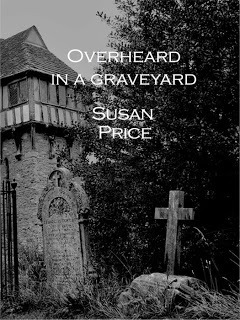 into the darkness of winter, traditionally the time to tell ghost stories. Which made me remember how I came to write the stories in my collection, Overheard In A Graveyard.
into the darkness of winter, traditionally the time to tell ghost stories. Which made me remember how I came to write the stories in my collection, Overheard In A Graveyard.
I remember the exact moment that the title story arrived. I was watching ‘Silent Tongue’ , starring River Phoenix as a simple boy whose father buys him a squaw for a wife. The woman dies and her body is wrapped in a blanket and ‘sky-buried’ in a tree – but the grief-stricken boy stands guard, scaring away birds with shots from his gun.
The woman’s ghost appears to him: and the film handles the ghost in a very simple, but effective way. She appears from the edge of the frame, or dashes across it – and as what appears within in the frame is ‘reality’ to us while we watch, she is, in effect suddenly appearing and vanishing without the need for any expensive computer trickery. She screams at the boy that he has to let her body be destroyed so her spirit can go on to the next world.
My head is stuffed with folklore, and I remembered all the many stories about grief for the dead keeping them from peace – ‘Who lies weeping on my grave and will not let me sleep? ’ I immediately wanted to write my own version of this theme – in fact, I started writing it then and there. I wanted to make it as simple and bare as a ballad – or a ghost who steps into view from the edge of a film frame.
As I worked, I cut all description of place and clothes. I didn’t want to pin it to any period or country. What you cut out is more important than what you leave in. I ended by reducing it to a dialogue between two voices. The title, ‘Overheard In A Graveyard,’ did the work of scene setting.
I cut out even ‘he said,’ and ‘she said.’ Which was male and which was female, anyway – the living or the dead? And who was to say the voices weren’t both male or both female? I left that for the reader to decide. Of all the stories I’ve written, it’s a favorite of mine.
Having started the collection with an ‘overheard’ story, I decided to end with another – ‘Overheard In A Museum.’ C. S. Lewis’ observed that we write from ‘the habitual furniture of our minds,’ and when I was 11, I collided with the Norse Myths. I’ve never been the same since. They left me with a fixed interest, not only in myths, but in the Viking Age. As a teenager, I read everything I could find about the Vikings, including accounts of the Oseberg and Gokstad ship burials. One day, I decided, I would go to Oslo’s Viking Ship Museum and see them – and so I did. I spent hours in there. The guards, impatient for home, eventually lured me out by laying a trail of chocolate.
‘Overheard In A Museum’ was inspired by that visit, though written two decades later. The voice overheard is that of the Gokstad war-ship, and the museum is the Viking Ship Museum which stands above the fjord where the ship once sailed.
Two stories, The Familiar, and Across The Fields, were originally written for anthologies of ‘scary’ stories published for Christmas. Across The Fields was based on a Cornish folk-tale I found in one of the collections I bought as a child while on holiday. I changed the setting to my own Black Country, among coal-mines instead of tin-mines. My Great Grandfather was a miner, and my grandfather worked at pits too. The background of the story – the primitive pits, the dark fields, the gas-lit, cobbled markets - was one I often heard described when I was a child. And Grace Mary, the gypsy girl who drowned herself in a marl-hole (a clay pit) was – is – a Black Country ghost.
The Familiar stems from Icelandic legend. The Icelanders are good at grue. It’s all those long, dark nights. They have a kind of ghost known as a ‘follower’, which attaches itself to a particular person or family. These ghosts can also be created by witches and wizards and sent to haunt people. I shifted this idea into a modern, English setting.
Inanna was originally written for an educational publisher, as an early reader. It was the publisher’s choice, and not one I was familiar with. I was a little surprised when I found out what a goer Inanna was – but, hey, I’m just the hack. I writes what I’m asked to write.
I found and combined several versions of the myth, but was most charmed by a close translation of the original (one of the oldest written stories in the world) which I found – where else? – on the internet. I particularly liked the Great God Enki fussing like an old mother hen: ‘Oh, what has Inanna done now? She has Me worried. What has the Queen of Heaven done? Oh, that Girl worries Me. What is the Mistress of All Lands up to now? She worries Me, She does…’
That Girl worried my publishers too, when they saw the finished story. She was too sexy, her tale too horrific… Honestly, what were they expecting from a Goddess of Desire and War? I decided to kindle it, instead of wasting it. I like it – it’s a very ancient explanation of summer and winter, a forerunner of the Persephone myth.
Cruel Mother is another story that came in a flash. I was on the treadmill in the gym, listening to music through headphones. The song that triggered the story was the folk-ballad, ‘The Cruel Mother’,about a woman who murders her newborn baby. It leaped into my head that I should off-set the old ballad’s verses with scenes from the same story, set today. The result isn’t a barrel of laughs, it’s true; but it does achieve something of the effect I was aiming for.
Missing the Bus came from my brother telling me about his work in a call-centre, where he told callers the bus and train timetables. He worked nights, and his description gave me this image of a tall, illuminated tower in darkness, with many voices rising up to it. The snatches of conversation in the story are based on conversations he actually had with callers.
Footsteps on the Stairs is from an account I read, years ago, in a collection of ‘true’ ghost stories, which I sometimes prefer to invented ones, because nothing is neatly explained. The ghost hasn’t come to warn anyone, or for revenge, to lead the way to treasure or to right a wrong. It remains an odd, inexplicable incident.
Finally, Mow Top, which I owe to my friend, fellow-writer and ebook-buddy, Katherine Roberts. Kath and I are both members of the Scattered Authors’ Society (SAS), and I was at the SAS ‘retreat’ one summer a couple of years ago, when Kath ran a ‘collage workshop.’ First we had to concentrate our minds on the kind of story we wanted to write. I knew I wanted to write a ghost story.
Then we riffled through piles of old magazines for five minutes, ripping out any image or words that caught our eye, without stopping to think about it.
Next, we took our heap of rippings and made a collage from them. I had a moorland scene, the phrase ‘buried in an unmarked grave’, and a flight of steps going down into the dark cellar of a ruined building, with which I associated the phrase ‘descending to the Underworld.’
On finishing our collages, we all had to speak about them. I could think of nothing to say about mine, though I did feel it had some significance for me which I couldn’t put it into words. But the point of the exercise is that, often, our best ideas come from that part of the brain which has no words.
Anyway, it was lunchtime and, as my room was near where we’d been working, I threw the collage on my bed and forgot about it. Hours later – hours of lively, stimulating SAS company – I returned, took one look at the collage, and had the story, Mow Top, complete in my head. It seemed to spring from the collage straight into my head, fully formed.
There was still a lot of writing and rewriting to do, but the story didn’t change much.
 into the darkness of winter, traditionally the time to tell ghost stories. Which made me remember how I came to write the stories in my collection, Overheard In A Graveyard.
into the darkness of winter, traditionally the time to tell ghost stories. Which made me remember how I came to write the stories in my collection, Overheard In A Graveyard.I remember the exact moment that the title story arrived. I was watching ‘Silent Tongue’ , starring River Phoenix as a simple boy whose father buys him a squaw for a wife. The woman dies and her body is wrapped in a blanket and ‘sky-buried’ in a tree – but the grief-stricken boy stands guard, scaring away birds with shots from his gun.
The woman’s ghost appears to him: and the film handles the ghost in a very simple, but effective way. She appears from the edge of the frame, or dashes across it – and as what appears within in the frame is ‘reality’ to us while we watch, she is, in effect suddenly appearing and vanishing without the need for any expensive computer trickery. She screams at the boy that he has to let her body be destroyed so her spirit can go on to the next world.
My head is stuffed with folklore, and I remembered all the many stories about grief for the dead keeping them from peace – ‘Who lies weeping on my grave and will not let me sleep? ’ I immediately wanted to write my own version of this theme – in fact, I started writing it then and there. I wanted to make it as simple and bare as a ballad – or a ghost who steps into view from the edge of a film frame.
As I worked, I cut all description of place and clothes. I didn’t want to pin it to any period or country. What you cut out is more important than what you leave in. I ended by reducing it to a dialogue between two voices. The title, ‘Overheard In A Graveyard,’ did the work of scene setting.
I cut out even ‘he said,’ and ‘she said.’ Which was male and which was female, anyway – the living or the dead? And who was to say the voices weren’t both male or both female? I left that for the reader to decide. Of all the stories I’ve written, it’s a favorite of mine.
Having started the collection with an ‘overheard’ story, I decided to end with another – ‘Overheard In A Museum.’ C. S. Lewis’ observed that we write from ‘the habitual furniture of our minds,’ and when I was 11, I collided with the Norse Myths. I’ve never been the same since. They left me with a fixed interest, not only in myths, but in the Viking Age. As a teenager, I read everything I could find about the Vikings, including accounts of the Oseberg and Gokstad ship burials. One day, I decided, I would go to Oslo’s Viking Ship Museum and see them – and so I did. I spent hours in there. The guards, impatient for home, eventually lured me out by laying a trail of chocolate.
‘Overheard In A Museum’ was inspired by that visit, though written two decades later. The voice overheard is that of the Gokstad war-ship, and the museum is the Viking Ship Museum which stands above the fjord where the ship once sailed.
Two stories, The Familiar, and Across The Fields, were originally written for anthologies of ‘scary’ stories published for Christmas. Across The Fields was based on a Cornish folk-tale I found in one of the collections I bought as a child while on holiday. I changed the setting to my own Black Country, among coal-mines instead of tin-mines. My Great Grandfather was a miner, and my grandfather worked at pits too. The background of the story – the primitive pits, the dark fields, the gas-lit, cobbled markets - was one I often heard described when I was a child. And Grace Mary, the gypsy girl who drowned herself in a marl-hole (a clay pit) was – is – a Black Country ghost.
The Familiar stems from Icelandic legend. The Icelanders are good at grue. It’s all those long, dark nights. They have a kind of ghost known as a ‘follower’, which attaches itself to a particular person or family. These ghosts can also be created by witches and wizards and sent to haunt people. I shifted this idea into a modern, English setting.
Inanna was originally written for an educational publisher, as an early reader. It was the publisher’s choice, and not one I was familiar with. I was a little surprised when I found out what a goer Inanna was – but, hey, I’m just the hack. I writes what I’m asked to write.
I found and combined several versions of the myth, but was most charmed by a close translation of the original (one of the oldest written stories in the world) which I found – where else? – on the internet. I particularly liked the Great God Enki fussing like an old mother hen: ‘Oh, what has Inanna done now? She has Me worried. What has the Queen of Heaven done? Oh, that Girl worries Me. What is the Mistress of All Lands up to now? She worries Me, She does…’
That Girl worried my publishers too, when they saw the finished story. She was too sexy, her tale too horrific… Honestly, what were they expecting from a Goddess of Desire and War? I decided to kindle it, instead of wasting it. I like it – it’s a very ancient explanation of summer and winter, a forerunner of the Persephone myth.
Cruel Mother is another story that came in a flash. I was on the treadmill in the gym, listening to music through headphones. The song that triggered the story was the folk-ballad, ‘The Cruel Mother’,about a woman who murders her newborn baby. It leaped into my head that I should off-set the old ballad’s verses with scenes from the same story, set today. The result isn’t a barrel of laughs, it’s true; but it does achieve something of the effect I was aiming for.
Missing the Bus came from my brother telling me about his work in a call-centre, where he told callers the bus and train timetables. He worked nights, and his description gave me this image of a tall, illuminated tower in darkness, with many voices rising up to it. The snatches of conversation in the story are based on conversations he actually had with callers.
Footsteps on the Stairs is from an account I read, years ago, in a collection of ‘true’ ghost stories, which I sometimes prefer to invented ones, because nothing is neatly explained. The ghost hasn’t come to warn anyone, or for revenge, to lead the way to treasure or to right a wrong. It remains an odd, inexplicable incident.
Finally, Mow Top, which I owe to my friend, fellow-writer and ebook-buddy, Katherine Roberts. Kath and I are both members of the Scattered Authors’ Society (SAS), and I was at the SAS ‘retreat’ one summer a couple of years ago, when Kath ran a ‘collage workshop.’ First we had to concentrate our minds on the kind of story we wanted to write. I knew I wanted to write a ghost story.
Then we riffled through piles of old magazines for five minutes, ripping out any image or words that caught our eye, without stopping to think about it.
Next, we took our heap of rippings and made a collage from them. I had a moorland scene, the phrase ‘buried in an unmarked grave’, and a flight of steps going down into the dark cellar of a ruined building, with which I associated the phrase ‘descending to the Underworld.’
On finishing our collages, we all had to speak about them. I could think of nothing to say about mine, though I did feel it had some significance for me which I couldn’t put it into words. But the point of the exercise is that, often, our best ideas come from that part of the brain which has no words.
Anyway, it was lunchtime and, as my room was near where we’d been working, I threw the collage on my bed and forgot about it. Hours later – hours of lively, stimulating SAS company – I returned, took one look at the collage, and had the story, Mow Top, complete in my head. It seemed to spring from the collage straight into my head, fully formed.
There was still a lot of writing and rewriting to do, but the story didn’t change much.
Published on November 01, 2013 17:05
October 25, 2013
Chess
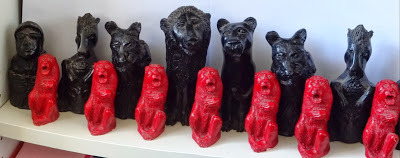
These are more of the things rescued when we cleared my late parents' house early this year.
They are chessmen - the red baboons at the front are pawns.
My father made them. He modelled originals from plasticine, then painted them with latex to form moulds, into which he poured plaster of paris.
The castles, or rooks, are self-portraits. Dad must have made them before he decided to grow the beard he always had in his later years.
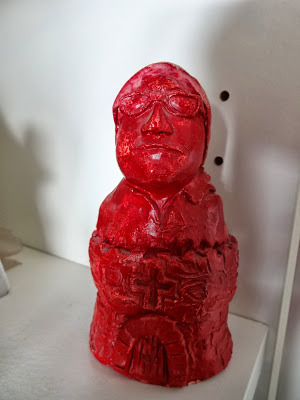 The kings and queens are lions and lionesses.
The kings and queens are lions and lionesses. 
The knights are horses, of course, holding shields. The bishops are sly foxes, with wine bottles in the pockets of their robes.
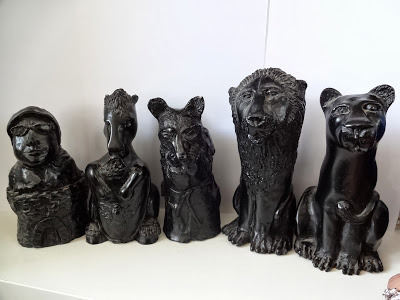
They live with my younger brother now, which is apt, as Adam is as likely to carve or model as he is to draw or paint. He always was. I remember, when he was four, he carried a lump of plasticine around with him all the time, and once showed me a model he'd made of our budgie. It wasn't the stereotypical 'bird-shape' I expected, but an acutely observed replica of a budgie. The flattened face, the long tail - umistakeably a budgie.
It was the first time I'd seriously thought that such talent might be inborn rather than taught - because what he saw all around him, in our family, was 2-D drawing and painting. No one had taught him, at such a young age, to observe and model like that.
He continued to show a gift for 3-D work - he would build model aircraft and, when he'd finished them, use the spare parts and bits of sprue to build strange little robots armed with lances. So I think Dad's chessmen have found their rightful home - and thanks to Patti for the photos.
Published on October 25, 2013 16:05
October 18, 2013
Okay, This Makes Me Mad...
EU Rule That Food Industry Can Call High Fructose Food Syrup Healthy
I quote from The Guardian, (17/10/2013)

More and more evidence is slotting into place to show that sugar, not fat, is the underlying cause of 'the obesity epedemic.' And that the worst, most poisonous, most dangerous kind of sugar is High Fructose Corn Syrup (HFCS). Ever since it was introduced, in the 1970s, obesity and the incidence of related ill-health has risen in step with its use. All over the world. Wherever HFCS is introduced, obesity, diabetes 2, heart disease, liver disease, and other related diseases quickly follow. The Food Industry love it, because it is very cheap and they need to use much less to make food sweet. Therefore their profits climb. American farmers love it, because it made them rich. American politicians love it, because it keeps the price of food - albeit junk food - cheap, and helps them win elections. And now our politicians, in the EU and UK are following their lead. Our Food Industry - in as much as it's 'ours' in these multi-national days - are keen to follow. They poison us to get rich - and blame it all on us. Because you put the food in your mouth, right? So, even though they told you it was 'healthy', it's your fault. You believed them, you fool. You believed your government, you idiot. The whole EU argument is based on the 'fact' that HFCS has a lower GI - that is, it doesn't cause as high and sudden a spike in blood-sugar as refined white sugar, or sucrose. This is so simplistic, and ignores so much recent research, that it takes the breath away. It ignores the fact that HFCS is worse than sugar, bad as refined sugar is. If 'poison' is defined as something which damages health when introduced into the body, then HFCS is a poison. You don't have to take it from me. Here's the highly qualified and experienced Dr. Robert Lustig. His lecture is too long to embed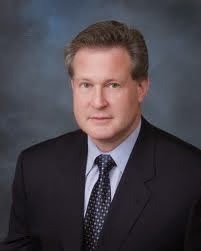 Robert Lustig, MDhere, but this is the link - http://www.youtube.com/watch?v=dBnniua6-oM It is long, but he's a highly entertaining and charming lecturer, and it's well worth watching. He explains how closely ethenol - alchohol - and HFCS are linked, and how the body metabalises both in the liver, because the rest of the body can't handle the stuff or use it. Which makes both poisons. But, as he points out, we've admitted that alcohol is a poison for centuries - and regulated it. If I understand correctly, HFCS doesn't cause a spike in blood-sugar because your body identifies it as poison and shunts it straight to the liver - the de-toxifying organ. And the liver struggles to deal with it, especially in the volumes of it we consume, in, say, fizzy drinks. Both alcohol and HFCS cause a build up of fat in the liver, and inflammation - cirrhosis. They both cause obesity, and also increase in appetite (because the hormone which tells us we've eaten enough, leptin, is inhibited.) They both cause hyper-tension, clogging of arteries and lead to heart-failure. It increases the risk of gout. And this is the stuff that the EU is going to allow to be labelled and advertised as 'healthy'. Mothers are going to be targeted by the Food Industry and told that this 'fruit-juice' - flavoured, coloured HFCS - is 'healthy'. It's going to be put - even more than it is now - into yoghurt, bread, ready-meals, cakes, biscuits, cereals, drinks, sauces, pickles... And every jar, tin and packet is going to be labelled 'healthy.' And 'natural.' One of your five a day.
Robert Lustig, MDhere, but this is the link - http://www.youtube.com/watch?v=dBnniua6-oM It is long, but he's a highly entertaining and charming lecturer, and it's well worth watching. He explains how closely ethenol - alchohol - and HFCS are linked, and how the body metabalises both in the liver, because the rest of the body can't handle the stuff or use it. Which makes both poisons. But, as he points out, we've admitted that alcohol is a poison for centuries - and regulated it. If I understand correctly, HFCS doesn't cause a spike in blood-sugar because your body identifies it as poison and shunts it straight to the liver - the de-toxifying organ. And the liver struggles to deal with it, especially in the volumes of it we consume, in, say, fizzy drinks. Both alcohol and HFCS cause a build up of fat in the liver, and inflammation - cirrhosis. They both cause obesity, and also increase in appetite (because the hormone which tells us we've eaten enough, leptin, is inhibited.) They both cause hyper-tension, clogging of arteries and lead to heart-failure. It increases the risk of gout. And this is the stuff that the EU is going to allow to be labelled and advertised as 'healthy'. Mothers are going to be targeted by the Food Industry and told that this 'fruit-juice' - flavoured, coloured HFCS - is 'healthy'. It's going to be put - even more than it is now - into yoghurt, bread, ready-meals, cakes, biscuits, cereals, drinks, sauces, pickles... And every jar, tin and packet is going to be labelled 'healthy.' And 'natural.' One of your five a day.
Whenever you see a food or drink labelled 'natural', 'low-fat' or 'healthy' - be very, very suspicious.
We're in the middle of an obesity epidemic, we're told. Diabetes 2 and obesity threaten the future of our Health Service. And our leaders' response? Not only let the Food Industry pump even more poisonous, addictive High Fructose Corn Syrup into our food - but let them claim that it's healthy!
Now let's pause a moment and ask why they're doing this? Is it because they've yielded to Food Industry pressure without bothering to read any of the research? Have they yielded to Food Industry pressure because they're too stupid to understand the research? Or have they yielded to Food Industry pressure because of lobbying from vested interests whose main concern is the money to be made? Regardless of how much pain and suffering their product causes - regardless of whether it destroys the NHS?
Which would you consider to be their best excuse? Or the most likely reason? Which reason makes them least fit to hold office or make any decisions on our behalf?
 And let's bring in something else - our government recently passed the third reading of 'The Gagging Law', which they claim is to control lobbying by vested interests. Which would be a good thing, if it actually did that. But it doesn't. (Read more about The Gagging Law here, on the 38 Degrees campaign site.) What it does is target individuals and charities, and prevent them from campaigning on issues before an election. It would make it illegal, for instance, for me to write this blog and bring this matter to your attention during the run-up to an election. You might, for instance, after reading this, think it was not a good idea to vote for any government that supported the EU in labelling a poison 'healthy'. And that would disappoint the Food Industry. It would be undemocratic and grossly unfair to millionaire MPs and the Food Industry, now wouldn't it? Why would this government of millionaires, relations of the queen, and people who sit on the boards of big multi-nationals want such a law passed, do you suppose? I remember, years and years ago, watching a documentary about the Tobacco Industry - at about the time they were fighting against the clearer and clearer evidence that smoking was a cause of lung-cancer. I wish I could post a link to the programme, but sorry, I can't. One moment of it, however, stays very clear in my memory. An American tobacco executive was being questioned by an off-screen interviewer, as he defended tobacco, and advertisements for it aimed at children. The off-screen voice asked, 'Do you allow your children to smoke?' This simple question seemed to cause the executive some difficulty. He ummed and ahhed, and tried to evade it. The off-screen voice repeated the question. If tobacco was harmless, and advertising it by using cartoon characters that appealed to children was harmless, then surely he allowed his children to smoke - right? The executive blustered for a few more moments. (He would never have been allowed in front of camera these days.) Then he relaxed as an answer came to him. Leaning back in his chair and smiling, he said, "Listen. Smoking is for the young, poor and stupid." His body language and smirk made it clear that he thought this a clinching argument, a piece of devastating wit and insight. The camera remained on him, and the interviewer kept silent, letting the executive's remark hang there. The camera remained on him as his smirk faded and his eyes became shifty. Had the thought crossed his mind that perhaps his clever remark hadn't been so clever after all? I remember it because it was one of the most shocking, revealing things I've ever heard. There, summed up in eight words, was the Tobacco Industry's attitude to its customers. There, stripped bare, was the utter contempt for us, and bigotry, that lies behind all that clever, sumptuous, calculated packaging and advertising. And Big Tobacco and Big Sugar are often the same companies. The people behind them have the same attitude to us. Cereal that's more than 50% sugar and advertised with funny cartoon characters? Fizzy drinks that are slightly flavoured High Fructose Corn Syrup? Bread stuffed with so much sugar that it's really cake? All marketed to the young, poor and stupid. Obesity? Diabetes 2? Heart disease? Liver disease? - They're for the young, poor and stupid. I find that the image of that executive's smug face is a great aid to eating genuinely healthy food. I gave up food containing added sugar in January this year, and I can't say that I've missed it. I also find that I zip round the supermarket, buying fresh meat, fruit and veg, without even noticing the shelves of cakes, biscuits, desserts etc. Not even chocolate attracts me any more. I no longer have to use will-power to pass the aisles of sugar-laden packages. They no longer even register with me. But if I was ever tempted again... I think I'd only have to imagine my money going into the pocket of some Food Industry executive who sneered at me for being, if not young, then stupid and poor. The sugary item would go back on the shelf. I think I'd rather live on raw cabbage and liver than contribute a single penny to his income. But the EU are going to give him a helping hand!
And let's bring in something else - our government recently passed the third reading of 'The Gagging Law', which they claim is to control lobbying by vested interests. Which would be a good thing, if it actually did that. But it doesn't. (Read more about The Gagging Law here, on the 38 Degrees campaign site.) What it does is target individuals and charities, and prevent them from campaigning on issues before an election. It would make it illegal, for instance, for me to write this blog and bring this matter to your attention during the run-up to an election. You might, for instance, after reading this, think it was not a good idea to vote for any government that supported the EU in labelling a poison 'healthy'. And that would disappoint the Food Industry. It would be undemocratic and grossly unfair to millionaire MPs and the Food Industry, now wouldn't it? Why would this government of millionaires, relations of the queen, and people who sit on the boards of big multi-nationals want such a law passed, do you suppose? I remember, years and years ago, watching a documentary about the Tobacco Industry - at about the time they were fighting against the clearer and clearer evidence that smoking was a cause of lung-cancer. I wish I could post a link to the programme, but sorry, I can't. One moment of it, however, stays very clear in my memory. An American tobacco executive was being questioned by an off-screen interviewer, as he defended tobacco, and advertisements for it aimed at children. The off-screen voice asked, 'Do you allow your children to smoke?' This simple question seemed to cause the executive some difficulty. He ummed and ahhed, and tried to evade it. The off-screen voice repeated the question. If tobacco was harmless, and advertising it by using cartoon characters that appealed to children was harmless, then surely he allowed his children to smoke - right? The executive blustered for a few more moments. (He would never have been allowed in front of camera these days.) Then he relaxed as an answer came to him. Leaning back in his chair and smiling, he said, "Listen. Smoking is for the young, poor and stupid." His body language and smirk made it clear that he thought this a clinching argument, a piece of devastating wit and insight. The camera remained on him, and the interviewer kept silent, letting the executive's remark hang there. The camera remained on him as his smirk faded and his eyes became shifty. Had the thought crossed his mind that perhaps his clever remark hadn't been so clever after all? I remember it because it was one of the most shocking, revealing things I've ever heard. There, summed up in eight words, was the Tobacco Industry's attitude to its customers. There, stripped bare, was the utter contempt for us, and bigotry, that lies behind all that clever, sumptuous, calculated packaging and advertising. And Big Tobacco and Big Sugar are often the same companies. The people behind them have the same attitude to us. Cereal that's more than 50% sugar and advertised with funny cartoon characters? Fizzy drinks that are slightly flavoured High Fructose Corn Syrup? Bread stuffed with so much sugar that it's really cake? All marketed to the young, poor and stupid. Obesity? Diabetes 2? Heart disease? Liver disease? - They're for the young, poor and stupid. I find that the image of that executive's smug face is a great aid to eating genuinely healthy food. I gave up food containing added sugar in January this year, and I can't say that I've missed it. I also find that I zip round the supermarket, buying fresh meat, fruit and veg, without even noticing the shelves of cakes, biscuits, desserts etc. Not even chocolate attracts me any more. I no longer have to use will-power to pass the aisles of sugar-laden packages. They no longer even register with me. But if I was ever tempted again... I think I'd only have to imagine my money going into the pocket of some Food Industry executive who sneered at me for being, if not young, then stupid and poor. The sugary item would go back on the shelf. I think I'd rather live on raw cabbage and liver than contribute a single penny to his income. But the EU are going to give him a helping hand!
(I've posted on this subject before. You can read the post here.)
I quote from The Guardian, (17/10/2013)
'the EU has now ruled that food and drink manufacturers can claim their sweetened products are healthier if they replace more than 30% of the glucose and sucrose they contain with fructose.'Here's the link - http://www.theguardian.com/society/2013/oct/17/obesity-experts-appalled-eu-fructose-health-claim-approval

More and more evidence is slotting into place to show that sugar, not fat, is the underlying cause of 'the obesity epedemic.' And that the worst, most poisonous, most dangerous kind of sugar is High Fructose Corn Syrup (HFCS). Ever since it was introduced, in the 1970s, obesity and the incidence of related ill-health has risen in step with its use. All over the world. Wherever HFCS is introduced, obesity, diabetes 2, heart disease, liver disease, and other related diseases quickly follow. The Food Industry love it, because it is very cheap and they need to use much less to make food sweet. Therefore their profits climb. American farmers love it, because it made them rich. American politicians love it, because it keeps the price of food - albeit junk food - cheap, and helps them win elections. And now our politicians, in the EU and UK are following their lead. Our Food Industry - in as much as it's 'ours' in these multi-national days - are keen to follow. They poison us to get rich - and blame it all on us. Because you put the food in your mouth, right? So, even though they told you it was 'healthy', it's your fault. You believed them, you fool. You believed your government, you idiot. The whole EU argument is based on the 'fact' that HFCS has a lower GI - that is, it doesn't cause as high and sudden a spike in blood-sugar as refined white sugar, or sucrose. This is so simplistic, and ignores so much recent research, that it takes the breath away. It ignores the fact that HFCS is worse than sugar, bad as refined sugar is. If 'poison' is defined as something which damages health when introduced into the body, then HFCS is a poison. You don't have to take it from me. Here's the highly qualified and experienced Dr. Robert Lustig. His lecture is too long to embed
 Robert Lustig, MDhere, but this is the link - http://www.youtube.com/watch?v=dBnniua6-oM It is long, but he's a highly entertaining and charming lecturer, and it's well worth watching. He explains how closely ethenol - alchohol - and HFCS are linked, and how the body metabalises both in the liver, because the rest of the body can't handle the stuff or use it. Which makes both poisons. But, as he points out, we've admitted that alcohol is a poison for centuries - and regulated it. If I understand correctly, HFCS doesn't cause a spike in blood-sugar because your body identifies it as poison and shunts it straight to the liver - the de-toxifying organ. And the liver struggles to deal with it, especially in the volumes of it we consume, in, say, fizzy drinks. Both alcohol and HFCS cause a build up of fat in the liver, and inflammation - cirrhosis. They both cause obesity, and also increase in appetite (because the hormone which tells us we've eaten enough, leptin, is inhibited.) They both cause hyper-tension, clogging of arteries and lead to heart-failure. It increases the risk of gout. And this is the stuff that the EU is going to allow to be labelled and advertised as 'healthy'. Mothers are going to be targeted by the Food Industry and told that this 'fruit-juice' - flavoured, coloured HFCS - is 'healthy'. It's going to be put - even more than it is now - into yoghurt, bread, ready-meals, cakes, biscuits, cereals, drinks, sauces, pickles... And every jar, tin and packet is going to be labelled 'healthy.' And 'natural.' One of your five a day.
Robert Lustig, MDhere, but this is the link - http://www.youtube.com/watch?v=dBnniua6-oM It is long, but he's a highly entertaining and charming lecturer, and it's well worth watching. He explains how closely ethenol - alchohol - and HFCS are linked, and how the body metabalises both in the liver, because the rest of the body can't handle the stuff or use it. Which makes both poisons. But, as he points out, we've admitted that alcohol is a poison for centuries - and regulated it. If I understand correctly, HFCS doesn't cause a spike in blood-sugar because your body identifies it as poison and shunts it straight to the liver - the de-toxifying organ. And the liver struggles to deal with it, especially in the volumes of it we consume, in, say, fizzy drinks. Both alcohol and HFCS cause a build up of fat in the liver, and inflammation - cirrhosis. They both cause obesity, and also increase in appetite (because the hormone which tells us we've eaten enough, leptin, is inhibited.) They both cause hyper-tension, clogging of arteries and lead to heart-failure. It increases the risk of gout. And this is the stuff that the EU is going to allow to be labelled and advertised as 'healthy'. Mothers are going to be targeted by the Food Industry and told that this 'fruit-juice' - flavoured, coloured HFCS - is 'healthy'. It's going to be put - even more than it is now - into yoghurt, bread, ready-meals, cakes, biscuits, cereals, drinks, sauces, pickles... And every jar, tin and packet is going to be labelled 'healthy.' And 'natural.' One of your five a day.Whenever you see a food or drink labelled 'natural', 'low-fat' or 'healthy' - be very, very suspicious.
We're in the middle of an obesity epidemic, we're told. Diabetes 2 and obesity threaten the future of our Health Service. And our leaders' response? Not only let the Food Industry pump even more poisonous, addictive High Fructose Corn Syrup into our food - but let them claim that it's healthy!
Now let's pause a moment and ask why they're doing this? Is it because they've yielded to Food Industry pressure without bothering to read any of the research? Have they yielded to Food Industry pressure because they're too stupid to understand the research? Or have they yielded to Food Industry pressure because of lobbying from vested interests whose main concern is the money to be made? Regardless of how much pain and suffering their product causes - regardless of whether it destroys the NHS?
Which would you consider to be their best excuse? Or the most likely reason? Which reason makes them least fit to hold office or make any decisions on our behalf?
 And let's bring in something else - our government recently passed the third reading of 'The Gagging Law', which they claim is to control lobbying by vested interests. Which would be a good thing, if it actually did that. But it doesn't. (Read more about The Gagging Law here, on the 38 Degrees campaign site.) What it does is target individuals and charities, and prevent them from campaigning on issues before an election. It would make it illegal, for instance, for me to write this blog and bring this matter to your attention during the run-up to an election. You might, for instance, after reading this, think it was not a good idea to vote for any government that supported the EU in labelling a poison 'healthy'. And that would disappoint the Food Industry. It would be undemocratic and grossly unfair to millionaire MPs and the Food Industry, now wouldn't it? Why would this government of millionaires, relations of the queen, and people who sit on the boards of big multi-nationals want such a law passed, do you suppose? I remember, years and years ago, watching a documentary about the Tobacco Industry - at about the time they were fighting against the clearer and clearer evidence that smoking was a cause of lung-cancer. I wish I could post a link to the programme, but sorry, I can't. One moment of it, however, stays very clear in my memory. An American tobacco executive was being questioned by an off-screen interviewer, as he defended tobacco, and advertisements for it aimed at children. The off-screen voice asked, 'Do you allow your children to smoke?' This simple question seemed to cause the executive some difficulty. He ummed and ahhed, and tried to evade it. The off-screen voice repeated the question. If tobacco was harmless, and advertising it by using cartoon characters that appealed to children was harmless, then surely he allowed his children to smoke - right? The executive blustered for a few more moments. (He would never have been allowed in front of camera these days.) Then he relaxed as an answer came to him. Leaning back in his chair and smiling, he said, "Listen. Smoking is for the young, poor and stupid." His body language and smirk made it clear that he thought this a clinching argument, a piece of devastating wit and insight. The camera remained on him, and the interviewer kept silent, letting the executive's remark hang there. The camera remained on him as his smirk faded and his eyes became shifty. Had the thought crossed his mind that perhaps his clever remark hadn't been so clever after all? I remember it because it was one of the most shocking, revealing things I've ever heard. There, summed up in eight words, was the Tobacco Industry's attitude to its customers. There, stripped bare, was the utter contempt for us, and bigotry, that lies behind all that clever, sumptuous, calculated packaging and advertising. And Big Tobacco and Big Sugar are often the same companies. The people behind them have the same attitude to us. Cereal that's more than 50% sugar and advertised with funny cartoon characters? Fizzy drinks that are slightly flavoured High Fructose Corn Syrup? Bread stuffed with so much sugar that it's really cake? All marketed to the young, poor and stupid. Obesity? Diabetes 2? Heart disease? Liver disease? - They're for the young, poor and stupid. I find that the image of that executive's smug face is a great aid to eating genuinely healthy food. I gave up food containing added sugar in January this year, and I can't say that I've missed it. I also find that I zip round the supermarket, buying fresh meat, fruit and veg, without even noticing the shelves of cakes, biscuits, desserts etc. Not even chocolate attracts me any more. I no longer have to use will-power to pass the aisles of sugar-laden packages. They no longer even register with me. But if I was ever tempted again... I think I'd only have to imagine my money going into the pocket of some Food Industry executive who sneered at me for being, if not young, then stupid and poor. The sugary item would go back on the shelf. I think I'd rather live on raw cabbage and liver than contribute a single penny to his income. But the EU are going to give him a helping hand!
And let's bring in something else - our government recently passed the third reading of 'The Gagging Law', which they claim is to control lobbying by vested interests. Which would be a good thing, if it actually did that. But it doesn't. (Read more about The Gagging Law here, on the 38 Degrees campaign site.) What it does is target individuals and charities, and prevent them from campaigning on issues before an election. It would make it illegal, for instance, for me to write this blog and bring this matter to your attention during the run-up to an election. You might, for instance, after reading this, think it was not a good idea to vote for any government that supported the EU in labelling a poison 'healthy'. And that would disappoint the Food Industry. It would be undemocratic and grossly unfair to millionaire MPs and the Food Industry, now wouldn't it? Why would this government of millionaires, relations of the queen, and people who sit on the boards of big multi-nationals want such a law passed, do you suppose? I remember, years and years ago, watching a documentary about the Tobacco Industry - at about the time they were fighting against the clearer and clearer evidence that smoking was a cause of lung-cancer. I wish I could post a link to the programme, but sorry, I can't. One moment of it, however, stays very clear in my memory. An American tobacco executive was being questioned by an off-screen interviewer, as he defended tobacco, and advertisements for it aimed at children. The off-screen voice asked, 'Do you allow your children to smoke?' This simple question seemed to cause the executive some difficulty. He ummed and ahhed, and tried to evade it. The off-screen voice repeated the question. If tobacco was harmless, and advertising it by using cartoon characters that appealed to children was harmless, then surely he allowed his children to smoke - right? The executive blustered for a few more moments. (He would never have been allowed in front of camera these days.) Then he relaxed as an answer came to him. Leaning back in his chair and smiling, he said, "Listen. Smoking is for the young, poor and stupid." His body language and smirk made it clear that he thought this a clinching argument, a piece of devastating wit and insight. The camera remained on him, and the interviewer kept silent, letting the executive's remark hang there. The camera remained on him as his smirk faded and his eyes became shifty. Had the thought crossed his mind that perhaps his clever remark hadn't been so clever after all? I remember it because it was one of the most shocking, revealing things I've ever heard. There, summed up in eight words, was the Tobacco Industry's attitude to its customers. There, stripped bare, was the utter contempt for us, and bigotry, that lies behind all that clever, sumptuous, calculated packaging and advertising. And Big Tobacco and Big Sugar are often the same companies. The people behind them have the same attitude to us. Cereal that's more than 50% sugar and advertised with funny cartoon characters? Fizzy drinks that are slightly flavoured High Fructose Corn Syrup? Bread stuffed with so much sugar that it's really cake? All marketed to the young, poor and stupid. Obesity? Diabetes 2? Heart disease? Liver disease? - They're for the young, poor and stupid. I find that the image of that executive's smug face is a great aid to eating genuinely healthy food. I gave up food containing added sugar in January this year, and I can't say that I've missed it. I also find that I zip round the supermarket, buying fresh meat, fruit and veg, without even noticing the shelves of cakes, biscuits, desserts etc. Not even chocolate attracts me any more. I no longer have to use will-power to pass the aisles of sugar-laden packages. They no longer even register with me. But if I was ever tempted again... I think I'd only have to imagine my money going into the pocket of some Food Industry executive who sneered at me for being, if not young, then stupid and poor. The sugary item would go back on the shelf. I think I'd rather live on raw cabbage and liver than contribute a single penny to his income. But the EU are going to give him a helping hand! (I've posted on this subject before. You can read the post here.)
Published on October 18, 2013 16:05
October 4, 2013
Experiments in Scrivener - Part Aaargh!
 When I signed off last week, I was inclining towards buying Scrivener.
When I signed off last week, I was inclining towards buying Scrivener.I'm glad I experimented a little more before I did, because it's all gone horribly wrong.
One of the attractions of Scrivener, you see, was that, once you've finished your book, you can 'compile' it and produce it in any one of several formats - PDF, e-bookpub, mobi.
Since I publish e-books, I thought the mobi format (which is what Amazon's Kindle uses) would be useful. And as I would like to publish paper books with Amazon's CreateSpace, the PDF format would be useful too.
I had promised to send Anushree Prashant, of Ink Pantry
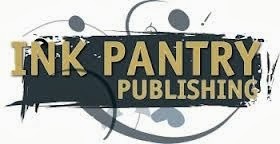 Publishing, a couple of my books, in PDF form, to review. I'd already sent her Ghost Drum - I produced the PDF from my files, using Word, in a couple of minutes.
Publishing, a couple of my books, in PDF form, to review. I'd already sent her Ghost Drum - I produced the PDF from my files, using Word, in a couple of minutes.I thought I'd send her Nightcomers as the second one, and use Scrivener to produce the PDF, so I could test-drive the 'compile' tool.
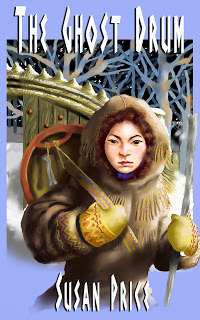 The Ghost Drum by Susan Price Four days later, I was still trying to produce that PDF. This, despite looking up many 'How To' tutorials on-line, by people who all raved about Scrivener, and how it was easy and 'intuitive' and 'free from care' (as Oliver Hardy used to say, immediately before everything went horribly wrong and the bricks fell on his head.)
The Ghost Drum by Susan Price Four days later, I was still trying to produce that PDF. This, despite looking up many 'How To' tutorials on-line, by people who all raved about Scrivener, and how it was easy and 'intuitive' and 'free from care' (as Oliver Hardy used to say, immediately before everything went horribly wrong and the bricks fell on his head.)Maybe I am overlooking something very obvious. I allow that possibility. On the other hand, I'm not thick, and I'm usually pretty quick to pick such things up.
I did produce PDFs - but none of them were as good, or as easy, or as quick as the one I produced with Word, by simply choosing 'Save as PDF' from the Word menu.
It's claimed that, in Scrivener, you have 'complete control' over the formatting of your book when you 'Compile' it. Well, so you do in Word, too. I found trying to get Scrivener to do as I wanted was maddeningly complicated, long-winded and difficult. And sometimes impossible.
For instance, Nightcomers is a collection of short stories. I didn't
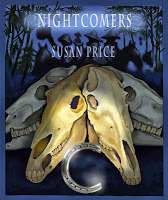 Nightcomers by Susan Pricewant each story to begin 'Chapter One, Chapter Two,' and so on. I wanted them to begin with the title of the story, and that alone.
Nightcomers by Susan Pricewant each story to begin 'Chapter One, Chapter Two,' and so on. I wanted them to begin with the title of the story, and that alone.Scrivener insisted that they begin with chapter headings. There is a template for 'a short story' but it's meant to produce a single short story, for submission to an editor. That is Scrivener's main purpose - to produce a manuscript for submission.
'"Compile" gives you complete control of your manuscript,' claimed all the how-to blogs and demos. I tried and tried to get rid of the chapter headings. I followed instructions, venturing deeper and deeper into the programme's bells and whistles, menu lists and tick-boxes. Sometimes I was hopeful - but that bloody chapter heading kept coming back, no matter what I did.
'Compile' also brings up a series of levels - Level 1, Level 1+, Level 2, Level Three.
Intuitive? Is it hell as like. I tried and tried to understand what was going on with these levels. Some seem to control titles alone, others text alone - sometimes you get blank, titled pages, sometimes not. Some are chapter folders, some are scenes, some are both... Fonts go astray, Bold comes and goes...
I read manuals and blogs, I watched videos. I tried my usual method of clicking buttons and observing what happens. None of it got me anywhere.
So, am I still going to buy Scrivener?
No - because I've reached the end of the time I'm prepared to spend fighting with it.
I'm sure I could learn how to use it, eventually - but would it be worth the time, effort and hair-loss?
I don't think so.
I like the planning part of it. It is good to have everything there on one screen - research, writing, corkboard, images.
But once you've done all that planning, you have to get it out of Scrivener, and that's a bloody nightmare. You could just copy and paste back into Word - but the programme is supposed to save you the trouble. And if you'd split your book up into lots of separate scenes, as Scrivener suggests, it would be an awful faff. A head-nipping fankle, in fact.
For a long time now I've been doing something very Scrivener-ish in Word, without going to any extra expense. And without my head being as severely nipped as it's been over the past few days.
Here, for instance, is a shot of a section of my Research File for Sterkarm 3.
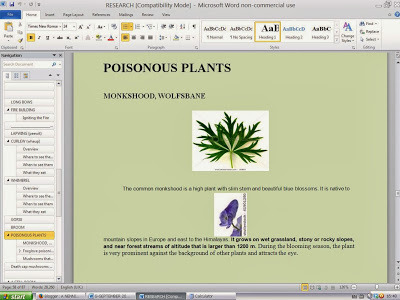
To the left you can see the 'Navigation Pane', which is also known as 'Document Map' in some versions of Word. You find it in Word's 'View' menu. Click on the box and the pane to the left appears.
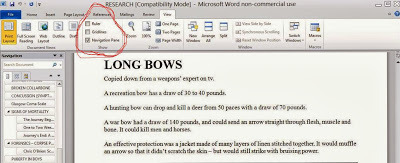
I made the heading 'Poisonous Plants' a 'Heading 1' by highlighting the words and then clicking 'Heading 1' (found in the 'Home' menu.) 'Poisonous Plants' then appears in the left hand Navigation pane.
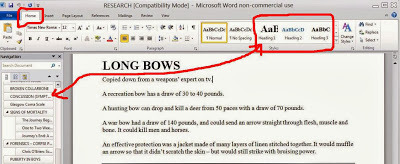
I wanted to have notes on several poisonous plants: Monkshood, Foxglove, Henbane - and then another section on poisonous mushrooms.
So I pasted in my notes, and then made the headings -
Monkshood, Foxglove, Henbane - into 'Headings 2'. They then appear in the Navigation pane, but inset, like this:
Poisonous Plants
Monkshood
Foxglove
Henbane
I can then make 'Poisonous Mushrooms' another Heading 1, so the whole looks like this -
Poisonous Plants
Monkshood
Foxglove
Henbane
Poisonous Mushrooms
Or, I could make the flowers Headings 3, and Mushrooms Heading 2 - in which case, it would look like this:-
Poisonous Plants
Monkshood
Foxglove
Henbane
Poisonous Mushrooms
Now the important point here is that, if I want to look up what research I have on poisonous plants, I don't have to scroll through the whole research document.
I just look down the Navigation Pane on the left. (I can scroll up and down it independently of the central, editing pane; and it's much shorter.) When I see these headings, I can click on 'Poisonous Plants' - and the cursor in the central Edit Pane jumps straight to that heading. (It's a hyperlink, like those in ebooks, but Word's Navigation Pane makes it very easy and quick to insert one.)
Or, I can click on any of the other Navigation headings - no matter what size they are - and I will be taken straight to that point in the file. I have notes - and Navigation Pane Headings - on medieval kitchens, still rooms, modern radio communications, sting grenades... and on and on.
As you can see, from the above, you can have images in these files. You save the image to desktop, and use 'insert picture' to add it to your Word file.
When I'm writing, and want to check something in my research file, I open another window, and open the research file in that, which means clicking from one to the other. But I could have both files visible on the same screen, with a split screen. If you go to the 'View' menu in Word, it offers you a choice of 'Open New Window' - which means you can open a new window from inside the file you're working on. (Circled in green.)
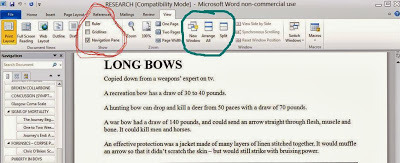
Or you can 'Split', which splits the screen horizontally. You can have different parts of the same file showing above and below the split, or you can open another file in one half of the split. (Scrivener gives you the option of splitting the screen vertically as well, if you think that would be useful.)
You could have all your writing and all your research in one gigantic Word file, and skip around it by using the Navigation Pane. (I imagine that, at some point, the file would become too big for Word to cope with, but text files can be massive before they cause modern computers problems.)
Personally, I find opening two windows, one for my writing and one for my research, is quite easy and quick. I don't like the split screen much, and prefer to open a new window.
So, as far as I can see, the only thing you get with Scrivener that you can't do with Word, is the corkboard toy. Which is a pretty good toy, I admit.
I enjoyed playing with it, and think I would find having my plans in front of me, and easily visable, very useful - but not useful enough to cough up £30 for that alone.
I think I might take a pointer from Scrivener, though, and set up 'Character' files in my research folders in future, with images and notes. I'll do the same for 'Locations'. Though I did do something similar for my Drovers' Dogs story, where the boy follows a drovers' route from the Fintry Hills to Mull.
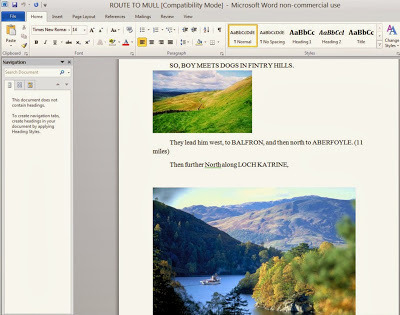 This only shows you part of the file. I could follow the route through the hills and lochs. My own memories, plus these visual cues, were a very effective shove to my imagination.
This only shows you part of the file. I could follow the route through the hills and lochs. My own memories, plus these visual cues, were a very effective shove to my imagination. Scrivener does allow you 30 days of trial USE, not simply 30 calendar days, which is generous. I might hang on to it for the days I have left, until I see what my A-E colleague, Chris Longmuir has to say about Scrivener in November, on the A-E How-To Day.
She loves the programme and, who knows, she may yet persuade me.
But I think, after all, I'll be sticking with Word.
Published on October 04, 2013 16:05
Susan Price's Nennius Blog
"I have made a little heap of all I've found..."
"I have made a little heap of all I've found..."
...more
- Susan Price's profile
- 71 followers



